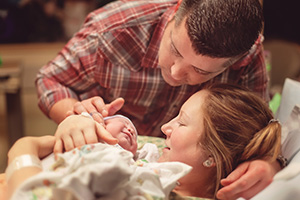Labor and Childbirth: Right after Birth
After childbirth, your healthcare provider will closely watch your recovery. You’ll likely be able to greet your baby right away. While you’re being cared for, your baby has their first exam.

Starting to bond
Bonding starts soon after birth. It’s also called attachment. It’s the close feeling of connection between your baby and you. It’s an ongoing process. It may take weeks or months. Be aware that you may not feel bonded with your baby right away. Most newborns don’t look like the chubby babies you see on TV. Your newborn will look wrinkled and puffy-eyed. This is due to months spent in your uterus and time in the birth canal. Most babies have a slightly pointed or misshapen head. These all go away after a few days.
After birth, your baby will likely be placed skin-to-skin on your chest. This allows your body to help regulate your baby's temperature. It can also start the bonding process. And it will signal your body to start making milk.
If you choose to breastfeed, your healthcare provider or nurse may help you introduce your baby to your breast to start breastfeeding. Newborn babies are usually very alert right after birth. They are ready to start breastfeeding. If you choose not to breastfeed, your healthcare provider will tell you how to stop milk production.
Starting your recovery
After birth, most women shake and get chills. This is over quickly. Your healthcare provider will watch your temperature and blood pressure until they are stable. The lining of your uterus will shed. Sanitary pads absorb the fluids. To make sure that you aren’t bleeding too much, the pad will be checked for the amount of blood. The firmness of your uterus will be checked. If you had anesthesia, your healthcare provider will watch you closely until you can feel and move your toes. If you have pain, they may give you pain medicine. If you have perineal pain, an ice pack can help.
Baby’s first exam
A healthcare provider will examine your baby in the first 5 minutes after birth. Or the exam may be done after you have had the chance to breastfeed your baby. Based on the exam, the provider will give your baby an APGAR score. This rates a baby’s:
Your baby may also be bathed, dried, weighed, and measured. Eye drops may be put in their eyes. This is to prevent infection. ID bracelets are placed around the baby’s wrist and ankle.